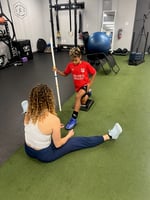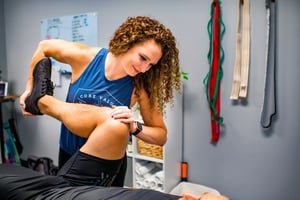Running efficiency isn’t just for elite athletes chasing race-day PRs. Whether you're training for...
Hip mobility for runners: why juicy hips help you run better!
Hip mobility is paramount for runners due to its pivotal role in optimizing performance, preventing injuries, and ensuring overall comfort during running activities.
What is mobility? It refers to the movement at a joint and the control of that movement. Tissues that contribute to mobility are ligaments, tendons, muscles, quality of the joint space as well as nervous tissue. Here's why hip mobility is crucial for runners:
- Efficient Running Mechanics: Proper hip mobility allows for a smooth and efficient running stride. It enables runners to achieve optimal range of motion in the hips, facilitating fluid movement and reducing energy expenditure. With adequate hip mobility, runners can maintain a balanced gait and propel themselves forward with ease.
- Injury Prevention: Limited hip mobility can lead to compensatory movements and increased stress on other joints and muscles, potentially predisposing runners to a variety of injuries. By maintaining adequate hip mobility, runners can distribute forces evenly throughout the body, reducing the risk of overuse injuries such as IT band syndrome, patellofemoral pain syndrome, and hip impingement. Having mobile hips also reduces the risk of hurting neighboring joints such as the lower back, SIJ or the knee.
- Enhanced Performance: Hip mobility directly impacts running performance by influencing stride length, cadence, and efficiency. Runners with greater hip mobility can achieve longer strides and generate more power with each step, resulting in faster race times and improved endurance. Additionally, optimal hip mobility allows for better engagement of the gluteal muscles, which are essential for propulsion and stability during running.
- Range of Motion: Adequate hip mobility enables runners to move through a full range of motion, both vertically and laterally. This flexibility is particularly important for negotiating varied terrain, navigating obstacles, and maintaining balance on uneven surfaces. Whether running on trails, roads, or tracks, runners with good hip mobility can adapt more easily to changing conditions and terrain.
- Comfort and Recovery: Optimal hip mobility contributes to overall comfort and enjoyment during running activities. Runners with restricted hip mobility may experience discomfort, tightness, or pain in the hips, lower back, or knees, which can detract from the running experience and hinder recovery. By prioritizing hip mobility, runners can reduce the likelihood of discomfort and enhance post-run recovery.
Click on the images below to get your hip mobility exercises
In conclusion, hip mobility is essential for runners to achieve efficient, injury-free and enjoyable running experiences and plays a crucial role in the performance and longevity of runners. By seeking professional help from our experienced team at Core Values Physical Therapy in Orlando, you can learn the targeted mobility exercises, stretches and preventative measures you need to take to achieve your running goals. Let us help you overcome obstacles, optimize your performance, and reach new heights in your running journey!
Ready to take the next step towards better hip mobility and running performance? Take action and schedule an appointment with one of our Doctors of Physical Therapy today!
Frequently Asked Questions:
How can physical therapy help improve hip mobility for runners?-
- Individualized exercises will be prescribed to target your mobility needs without risk for injury because you are under the watchful eye of your doctor of physical therapy. We also use modalities, such as dry-needling, to help you achieve ranges of motion easier than performing them alone
-
- Running is repetitive and only moves through the sagittal plane. This allows for stiffnesses to develop in the frontal plane and transverse plane if you don’t work on them.
Is it normal to experience hip pain while running, and when should I seek professional help?
-
- Some niggles, aches and slight discomforts are somewhat normal but here’s when you should seek professional help:
- Pain is greater than 4/10
- Pain is disconcerting
- Pain is limiting sleep, normal daily activities or causing you to limp
- Pain is recurring or will come and go often
- It is not improving
- Some niggles, aches and slight discomforts are somewhat normal but here’s when you should seek professional help:
-
- Consistency with drills, strength and mobility work
-
- You can start to see improvements right away because your nervous system will adjust but it takes about 14 days to see consistent and noticeable changes
-
- Yes it can so make sure you get a running assessment with a doctor of physical therapy at Core Values Physical Therapy in Orlando FL.



